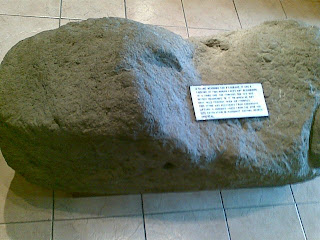2.14.2010 / Labels: Cebu Normal Univ. Museum
About Cebu Normal University Museum
 The Cebu Normal University museum consists of the permanent Collections of Pre-Spanish Era, Spanish Era, Philippine Revolution, Education Gallery, Natural History, and the Art Gallery sections.
The Cebu Normal University museum consists of the permanent Collections of Pre-Spanish Era, Spanish Era, Philippine Revolution, Education Gallery, Natural History, and the Art Gallery sections.The Cebu Normal University museum also features six puso designs, one for every class of gods in the ancient Cebuano animist religion.
Puso, the handy Cebuano invention which makes picnics so enjoyable, actually originated as an offering in religous rituals performed by our forebears during the pre-Spanish era.
The SUDLAY or harrow is a native farm implement used for breaking up large chunks of soil after plowing.
In the art gallery section, Cebu has a little-known classical tradition in sculpture, which has produced many examples of exceptional artistry.
The nude statue inspired by the very first Miss Universe, Armi Kuusela, was one of the later works of master sculptor Jovito Abellana, now in his 90's. Additionally, a bust of his granddaughter, done by award-winning sculptor Dr. Ramon Abellana and the American presence in our country is reflected in this bust of Abraham Lincoln, modeled from life by sculptor Leonard W. Volk in 1860.
Portrait of a typical Grade One teacher - one of the interesting items found in the Education Gallery of the CNU museum. More vintage photographs of early educators and their pupils are on exhibit in this gallery. The Pupils projects dating from the late Spanish and early American eras show fine workmanship can also be found in the gallery.
In the section on the Philippine Revolution is a portrait of the Mysterious Solomon Manalili, reputed to be the arms supplier of the Cebuano Katipuneros, He was later execute by the Spaniards.
The Spanish Era section features religious articles, such as this 1830's print entitled "La Verdadera Vina Cristiana". It also feature a brutal scene from World War II, painted by Cebuano artist Carmelo Tamayo can also be found.
In the Natural History section, the museum also contains a considerable collection of native flora and fauna.
Ambihid and Agusahis are two of our indigenous trees which have not yet been discovered by botanists. They are found in bonsai form in the museum.
The rock and mineral collection has some unusual-looking specimens. Opaline silica, Andesite, Weathered volcanic rock and Serpentinized Peridotite.
Cebu, as a coral-based island, is rich in fossils of various kinds. Many of these fossils are on display in the Natural History Section.
Address: Osmena Boulevard, Cebu City, Cebu
Telephone No. +63(32)253-6223, Fax. +63(32)254-1130
Museum Hours: Monday to Friday, 8:30 a.m. to 12:00 p.m. and 1:00 p.m. to 5:00 p.m. Saturday, By appointment only
Admission Fees: Elem./High School 5.00
College Students 10.00
Adults/Professionals 20.00
Out-of-school youth and Special Children (in groups) Free
/ Labels: Univ. of San Carlos Museum
Archaeological Gallery of Univ. of San Carlos Museum
Various burial artifacts of pre-Hispanic Filipinos are exhibited at the Archaelogical Gallery. These include boat coffins, lime-stone burial jars and coffins and jars of earthenware. These burial practices attest to the pre-Hispanic Filipinos' belief in life after death and, as well, give evidence of artistic ability. Early pottery for trade abroad is also on display.
/ Labels: Univ. of San Carlos Museum
The Ethnographic Gallery of Univ. of San Carlos Museum
 The Ethnographic Gallery displays the material culture of tribal communities including weapons, ethnographic, costumes, ornaments and betel chewing containers.
The Ethnographic Gallery displays the material culture of tribal communities including weapons, ethnographic, costumes, ornaments and betel chewing containers./ Labels: Univ. of San Carlos Museum
About University of San Carlos Museum
The University Museum was founded by Father Rudolf Rahmann, SVD, late anthropologist and former president of the University, 1967. The museum which is located to the right of the entrance of the University's Main Building on P. Del Rosario Street. has four galleries: Spanish Colonial, Ethonographic, Archeological and Natural Science.
Address: P. Del Rosario Street, Cebu City, Cebu
Telephone No. +63(32)253-1000 loc. 191
Contact person: Mrs. Malou Samson
Museum Hours: Monday to Friday, 8:30 a.m. to 12:00 p.m. and 1:30 p.m. to 5:30 p.m.
Saturday, 8:30 a.m. to 12:00 p.m.
Admission Fees: USC Free
Other Schools 10.00
General Public 30.00
Address: P. Del Rosario Street, Cebu City, Cebu
Telephone No. +63(32)253-1000 loc. 191
Contact person: Mrs. Malou Samson
Museum Hours: Monday to Friday, 8:30 a.m. to 12:00 p.m. and 1:30 p.m. to 5:30 p.m.
Saturday, 8:30 a.m. to 12:00 p.m.
Admission Fees: USC Free
Other Schools 10.00
General Public 30.00
Subscribe to:
Posts (Atom)





















.jpg)

